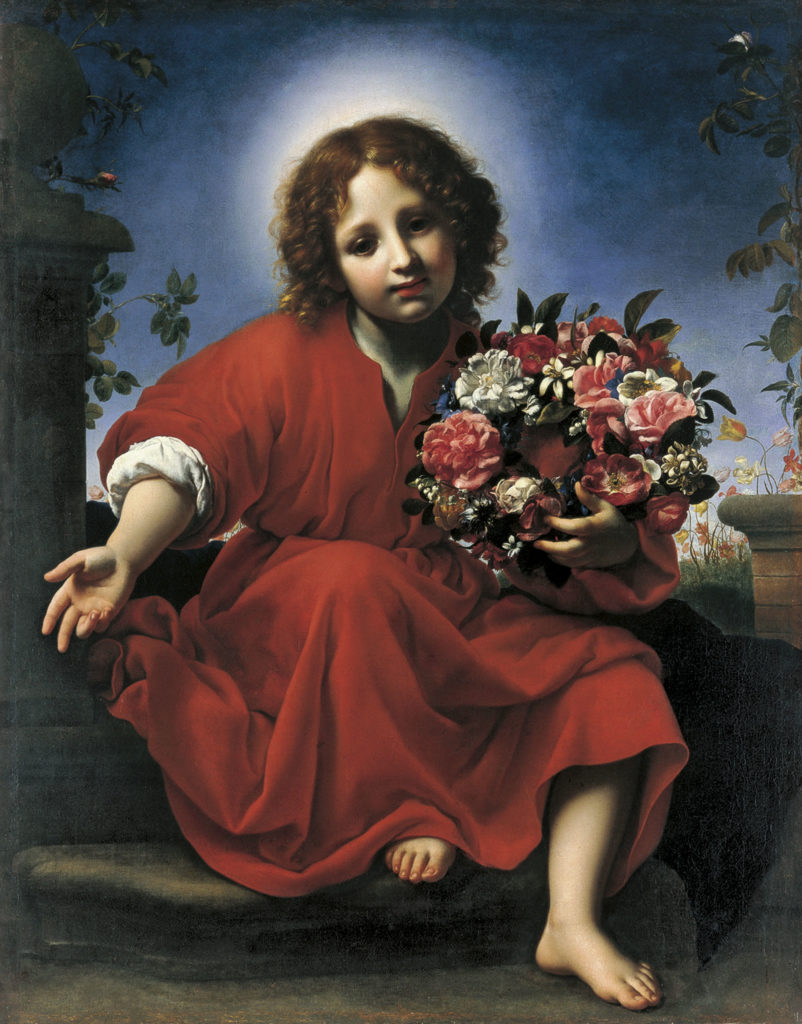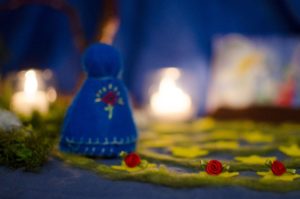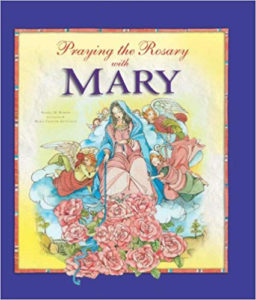
Maria walks amid the thorn . . .
Which seven years no leaf has born . . .
And as the two are passing near,
Lo! roses on the thorns appear.
Jesus and Maria.
—from “Maria Walks Amid the Thorn”
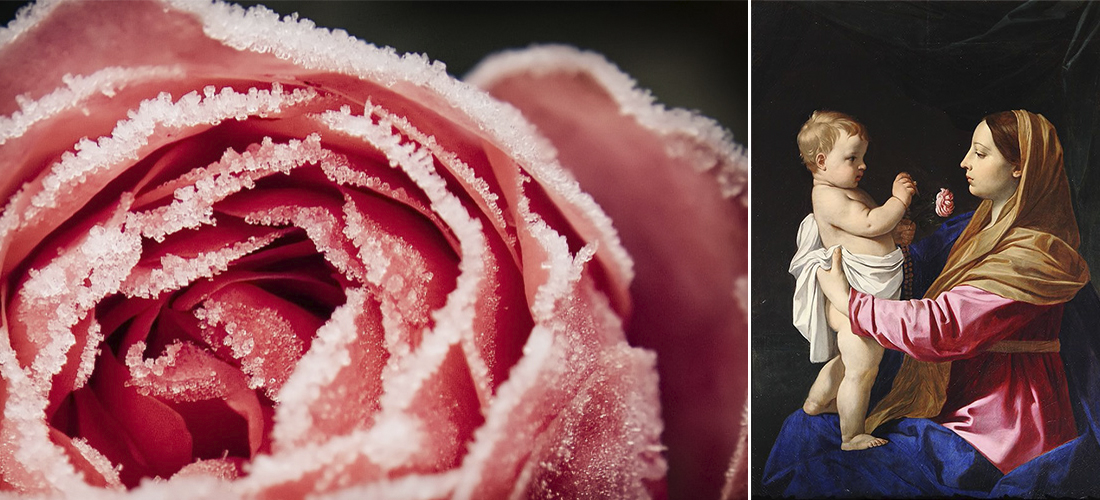
“For many centuries people could not believe that the symbolic content of the Christmas festival had ever had a beginning. They felt the hallmark of eternity in it . . . It is as though every year the soul is called upon to feel anew a reality which, it seems, could only have happened once.” [1]
So said the German philosopher Rudolf Steiner in a lecture he gave more than a century ago. In our thoroughly secular culture, the hope that we could feel anything like the hallmark of eternity in our Christmas celebrations is fast fading. Even Christian observances of this holy day can seem overly sentimental or lacking in depth, and leave one’s soul feeling more run-down than renewed. I, for one, would like to see Christmas with new eyes, and to experience it with a new spiritual fervor.
Yes, a truly new orientation toward Christmas is in order if we are going to recapture some of the deep mystery that accompanies the Nativity of our Lord Jesus Christ, and I think that perhaps one way this could be done is by listening to, and meditating upon, a trio of rose-themed Christmas hymns or carols. This is not an entirely new idea—the rose as a metaphor for Mary and Jesus (together or each alone) is an old one—but, using these rose hymns to enter more deeply into the mystery of the Incarnation is a novel concept for me. Perhaps it is for you, as well.
A Rose E’er Blooming
My revelation concerning the rose hymns stems from a passage in an anthology of Rudolf Steiner’s lectures that illuminated for me the importance of the image of the rose at Christmastide, and how meditating upon it might be the key to deepening my experience of the joyful mystery of the Incarnation. Matthew Barton, translator and editor of the Steiner anthology, writes: [2]
. . . Christ [is] the potent seed of the future, ripening from humanity’s fairest blossom Jesus, and from Mary, this blossom’s purest vessel. This powerful and beautiful image recalls old Christmas carols such as ‘Es ist ein Ros’ entsprungen’ . . . [T]he blossom born in the very midst of winter, when all other flowers have withered, contradicts the normal course of natural cycles, but for this very reason leads us directly to the non-physical reality which alone gives Christmas its meaning. At the same time, however, this meaning does not deny earthly reality and the physical world but inevitably passes through, renews, and is embodied in it. The spiritual flower cannot blossom without the physical world to root it.
I listened again to this beautiful German hymn, “Es ist ein Ros’ entsprungen (Lo how a rose e’er blooming),” which dates from the fifteenth century, [3] and suddenly felt as if I had descended further down the spiral that winds toward the beautiful mystery of Immanuel—God with us. The image of a single rose springing forth from the hard and frosted ground is marvelous, and points to something unutterable, and yet profoundly true, about the nature of the Christ Child and of Mary, His mother. Christ’s human body grows and blossoms from the chalice (calyx) of His mother, up from the earthly vine of Jesse. And, yet, this flower is not of this world; it is “e’er blooming”—both divine and timeless.
Roses on the Thorns Appear
It may have been the ninth century poet Sedulius who first made use of the rose metaphor in relation to Mary. He writes, “As the tender rose springs up among prickly thorns / But does not offend in any way, since its beauty obscures / its thorny branches, / So holy Mary, the new virgin descending / from the branch of Eve, / Makes pure the old virgin’s offense.” [4] Throughout the ages, both Mary and Jesus have been compared to the rose, one of nature’s most exquisite blooms, and often in contrast to the thorns that surround them.
This sentiment is echoed in the beautiful sixteenth century German hymn “Maria dorch ein Dornwald ging (Mary Walks Amid the Thorns),” [5] which tells the story of Mary walking through a desolate grove of thorns, where no flower has bloomed for many years. She carries within her the Christ Child and, as the two pass through the empty branches, roses spring forth from the barren vines in their wake. I had never heard this hymn before discovering it in my search for rose symbolism—it is one of the forgotten Advent hymns, as Maria von Trapp noted in her book Around the Year with the von Trapp Family.
This hymn, like all the rose hymns, points toward and makes accessible some aspect of Christ’s divinity in a way that other Christmas carols do not. And, it is precisely the mystery of Christ’s divinity and its relationship to His mother Mary—she who contained that which the heavens could not contain—that is often absent from our modern Christmas festival. In a recent discussion with David Clayton on his “The Way of Beauty” podcast, Rachel Fulton Brown beautifully articulates this need to re-embrace the mystery of Jesus’s divinity. [6] She says:
Modern Christians . . . tend to typically be focused much more on the earthly mysteries of Mary and Christ, so we’re always reading through the nineteenth century search for the historical Jesus . . . In the earthly meditations we’re focusing constantly on whether or not Mary is a good model for women . . . What’s lost . . . is the mystery of the Incarnation because we’re not taking the Divinity seriously . . . The mystery is: How could God have humbled Himself so much as to enter into His creation? . . . Are you really thinking about what that means . . . for the Creator of everything to have entered into His own work? . . . Anselm of Canterbury . . . talks about how Mary showed the world the Creator whom it had not seen.
Red Drops of Blood, like Roses Sprung
A final rose-themed carol closes the circle on this meditation, and gestures toward the fulfillment of the Christ Child’s destiny. Dating from the early twentieth century, “The Crown of Roses” tells an apocryphal story from Christ’s childhood, set in a rose garden. [7] The young child Jesus is sitting and calmly making rose garlands when a group of children arrive and begin teasing Him and picking the roses from the tree. He tells them to take everything but the thorns, which they then weave into a crown and press upon His head causing droplets of blood to appear.
I think there is a tendency to get caught up in the sweetness of the Christmas story—after all, the central character is an infant in a manger! Being confronted with the image of the the child Jesus wearing a crown of thorns is shocking, but even in the midst of this joyful season we must remember that Christ’s death and Resurrection are at the heart of the Incarnation. “[T]he Son of man came not to be served but to serve, and to give his life as a ransom for many.” (Matthew 20:28) “For this I was born and for this I came into the world, to testify to the truth.” (John 18:37)
The Rosary: A Spiritual Bouquet
In seeking out additional avenues for meaningful engagement with the Christmas Rose, as it were, the Rosary naturally comes to mind. Although many of us pray the Rosary regularly throughout the year, perhaps it could take on special significance at Christmastime. It is particularly appropriate to pray the Joyful Mysteries on Sundays throughout the Advent and Christmas seasons, and especially on Christmas Eve. In his book The World’s First Love, Archbishop Fulton Sheen discusses the connection between roses and prayers. [8] He writes:
. . . [A] deep instinct in humanity makes it associate roses with joy. Pagan peoples crowned their statues with roses as symbols of their own hearts. The faithful of the early Church substituted prayers for roses . . . [and] from this custom of offering spiritual bouquets arose a series of prayers known as the Rosary, for Rosary means ‘crown of roses.’
It is objected that there is much repetition in the Rosary because the Lord’s Prayer and the Hail Mary are said so often . . . The beautiful truth is that there is no repetition in, ‘I love you.’ Because there is a new moment of time, another point in space, the words do not mean the same as they did at another time or space . . . So the heart takes one expression, ‘I love you,’ and in saying it over and over again, it never repeats. It is the only real news in the universe. That is what we do when we say the Rosary, we are saying God, the Trinity, to the Incarnate Saviour, to the Blessed Mother: ‘I love You, I love You, I love you.’
Sharing the Christmas Rose with Children
We can sing with our children! We can learn the beautiful rose hymns in English or German and sing them together as a family. We can also play recordings of the rose hymns in the evenings during Advent and Christmas, with candlelight warming the room. We can display beautiful rose-themed images of Mary and Jesus, or add a miniature potted rose to our seasonal table—perhaps a little trail of roses could follow in Mary’s wake as she moves around the Advent spiral.
Another way to incorporate rose imagery into your Christmas activities is to have the children create rose ornaments for the Christmas tree. In her book Celebrating Festivals with Children, Brigitte Barz suggests crafting thirty-three rose ornaments to represent Christ’s life on Earth—thirty red and three white (to represent the years from Christ’s Baptism to His Passion). Barz notes that Rudolf Steiner saw the roses on the tree as “a symbol of the victory of the eternal over the temporal.” She also writes: [9][Note 1]
The rose . . . is strongly rooted in the earth. Underlying its form is a clearly recognizable principle of five, the five-pointed star, the pentagram. The five-pointed star is the star of fulfillment . . . this principle is clearly revealed: In the leaves, in the position of the leaves on the stem, and in its blossom, whether in the pure simple blossom of the wild rose or in the manifold beauty of the cultivated rose. The words of Schiller capture the quality of this wonderful plant, ennobled by the expertise of man: ‘Do you seek the highest, the greatest? The plant can teach it to you. This is it: What the plant is without trying, you can be through effort.’
Praying the Rosary is something we can, and absolutely should, do with our children. It is perfectly accessible to them—the Our Father and Hail Mary prayers are not difficult to memorize. You do not need to pray all five decades together, but even one decade at bedtime will bring truth, beauty, and goodness to their lives and encourage them to pray the Rosary as a daily spiritual practice. It may be helpful for children and adults to have a visual aid for meditating on the Joyful Mysteries. One might also purchase a “Scriptural Rosary” book that highlights passages from the Bible that tell the story of the various mysteries. Here are a few titles to consider:
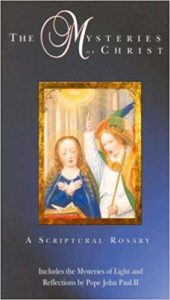
Did You Know?
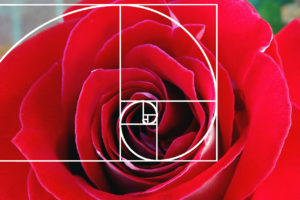
The rose is considered a perfect flower, from a botanical perspective. It contains all four structures necessary to make it complete (meaning, it has both male and female parts: Sepals, petals, stamens, and pistils).
Additionally, rose petals appear in accordance with the Fibonacci sequence or “Golden Ratio.” Indeed, the Fibonacci Spiral can be found throughout all of Creation, from pine cones and nautilus shells to the farthest reaches of the universe in spiral galaxies. The journalist Walter Johnson writes: [10]
The Fibonacci series and the golden ratio from which it derives, is at the basis of all life. It is proof of order and regularity in the universe and, as such, has religious significance . . . The petals of a rose growing out of the stem manifest this ratio . . . The Fibonacci numbers on a rose simply show that each petal is dependent on the others preceding it precisely in the Fibonacci series: Each new one is the sum of the two that came before.
NOTES
Note 1Here Barz quotes “das Höchste (The Highest),” a poem by the great German philosopher, playwright, historian, and poet Friedrich Schiller. In the original German, it reads: “Suchst du das Höchste, das Größte? Die Pflanze kann es dich lehren: / Was sie willenlos ist, sei du es wollend – das ists!” An alternate English translation is as follows: “Seekest thou the highest, the greatest? / In that the plant can instruct thee; / What she unwittingly is, be thou of thine own free will!”
ENDNOTES
1 Rudolph Steiner, Christmas: An Introductory Reader (Forest Row, England: Sophia Books/Rudolf Steiner Press, 2007), p 58
2 Ibid., p 137
3 “Es ist ein Ros entsprungen,” www.TheHymnsandCarolsofChristmas.com
4 Sedulius, Carmen Paschale, Book II, Verses 28-31, English trans. Gambero, p 284
5 “Maria Walks Amid the Thorn,” www.TheHymnsandCarolsofChristmas.com
6 “Episode 10 – Rachel Fulton Brown on How A True, Medieval-Style Devotion to Mary Will Save the Faith and the Culture,” www.TheWayofBeauty.org, 10/18/18, 16:44-19:34
7 “When Jesus Christ Was Yet A Child,” www.TheHymnsandCarolsofChristmas.com
8 “Roses and Prayers” by Bishop Fulton Sheen, www.CatholicTradition.org
9 Brigitte Barz, Celebrating Festivals with Children (Edinburgh, Scotland: Floris Books, 1991), pp 31-32; 75-76
10 “Are Roses in the Golden Ratio?” by Walter Johnson, www.GardenGuides.com, 9/21/17

“Lo, How a Rose E’er Blooming”
The rose hymns really must be heard to be appreciated. I spent quite a long time tracking down the most beautiful recordings I could find for each hymn, in both English and German (where applicable), so that I could share them with you. Audio icon opens YouTube video in a new window.
English Lyrics:
Lo, how a rose e’er blooming,
From tender stem hath sprung!
From Jesse’s lineage coming,
As men of old have sung.
It came, a floweret bright,
Amid the cold of winter
When half spent was the night.
Isaiah ’twas foretold it,
The Rose I have in mind.
With Mary we behold it,
The Virgin mother kind
To show God’s love aright,
She bore to men a Savior
When half spent was the night.
The shepherds heard the story
Proclaimed by angels bright,
How Christ, the Lord of Glory
Was born on earth this night.
To Bethlehem they sped
And in the manger found him,
As angel heralds said.
This Flower, whose fragrance tender
With sweetness fills the air,
Dispels with glorious splendor
The darkness everywhere;
True man, yet very God,
From Sin and death he saves us,
And lightens every load.
German Lyrics:
Es ist ein Ros entsprungen
aus einer Wurzel zart.
Wie uns die Alten sungen,
von Jesse kam die Art
und hat ein Blümlein bracht,
mitten im kalten Winter,
wohl zu der halben Nacht.
Das Röslein, das ich meine,
davon Jesaia sagt:
hat uns gebracht alleine
Marie die reine Magd.
Aus Gottes ew’gem Rat
hat sie ein Kind geboren
welches uns selig macht.
O Jesu, bis zum Scheiden
aus diesem Jammertal
laß Dein Hilf uns geleiten
hin in den Freudensaal,
in Deines Vaters Reich,
da wir Dich ewig loben;
o Gott, uns das verleih!
“Maria Walks Amid the Thorns”
English Lyrics:
Maria walks amid the thorn,
Kyrie eleison.
Which seven years no leaf has born,
She walks amid the wood of thorn.
Jesu and Maria.
What ‘neath her heart doth Mary bear?
Kyrie eleison.
A little child doth Mary bear,
Beneath her heart He nestles there.
Jesu and Maria.
And as with child she passes near,
Kyrie eleison,
Lo! roses on the thorns appear.
Lo! roses on the thorns appear.
Jesu and Maria.
What shall this infant callèd be?
Kyrie eleison.
The Christ this child shall callèd be
His name from all eternity.
Jesu and Maria.
Who hath the world from sin set free?
Kyrie eleison.
This child alone and only he,
He hath the world from sin set free.
Jesu and Maria.
German Lyrics:
Maria durch ein Dornwald ging,
Kyrie eleison.
Maria durch ein Dornwald ging,
Der hat in sieb’n Jahr kein Laub getragen.
Jesus und Maria.
Was trug Maria unter ihrem Herzen?
Kyrie eleison.
Ein kleines Kindlein ohne Schmerzen,
Das trug Maria unter ihrem Herzen.
Jesus und Maria.
Da hab’n die Dornen Rosen getragen,
Kyrie eleison.
Als das Kindlein durch den Wald getragen,
Da haben die Dornen Rosen getragen!
Jesus und Maria.
“The Crown of Roses”
When Jesus Christ was yet a child,
He had a garden small and wild,
Wherein He cherished roses fair,
And wove them into garlands there.
Now once, as summer time drew nigh,
There came a troop of children by,
And seeing roses on the tree,
With shouts they pluck’d them merrily.
“Do you bind roses in your hair?”
They cried, in scorn, to Jesus there.
The Boy said humbly: “Take, I pray,
All but the naked thorns away.”
Then of the thorns they made a crown,
And with rough fingers press’d it down,
Till on his forehead fair and young,
Red drops of blood, like roses sprung.
